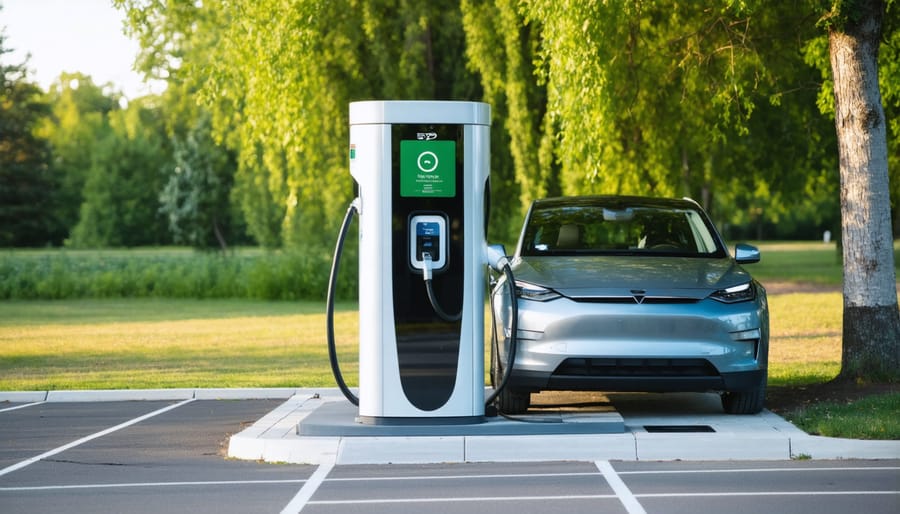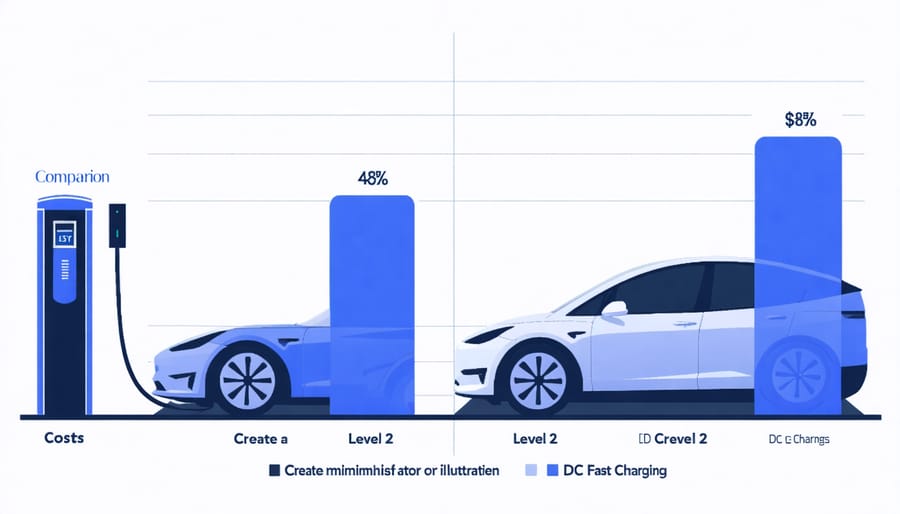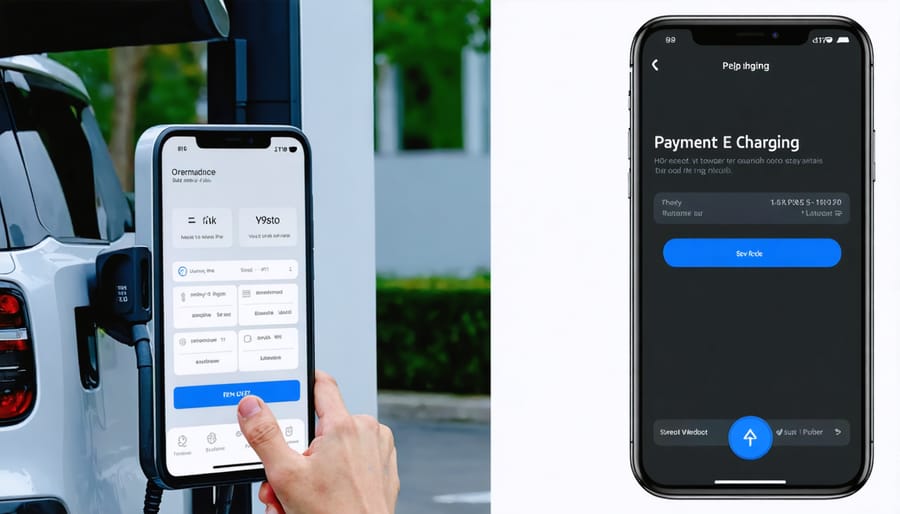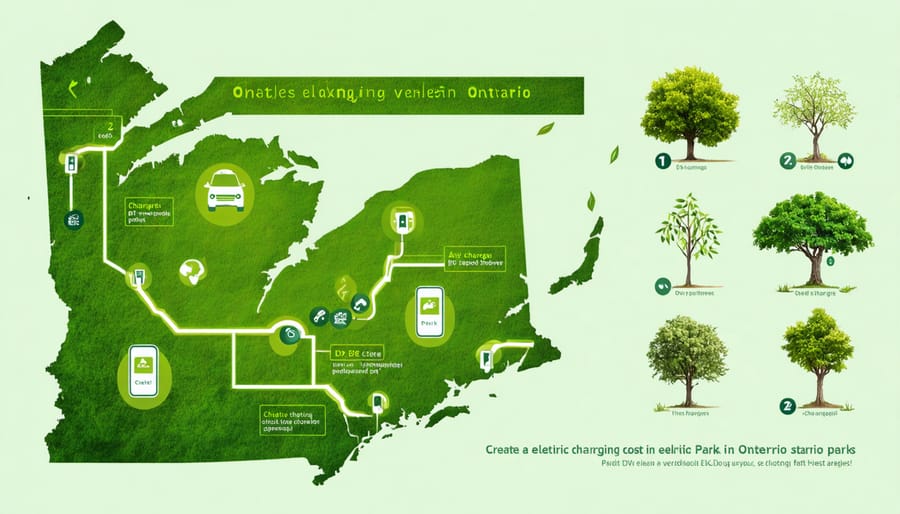Electric vehicle charging costs vary dramatically across Ontario, from free municipal stations to premium fast-charging hubs that can cost up to $25 per session. EV charging facilities in Ontario parks typically range from $2-4 per hour, making them an affordable option for eco-conscious adventurers. Level 2 chargers, the most common type found at public locations, average $1.50 to $2.50 per hour, while DC fast chargers command premium rates of $15-20 per session. Understanding these price variations helps drivers plan their routes and budget effectively, especially for longer trips through the province’s extensive network of charging stations. Recent government incentives have expanded charging infrastructure, making it increasingly convenient to travel emission-free while exploring Ontario’s natural beauty.
Current EV Charging Options in Ontario Parks

Level 2 vs. DC Fast Charging Stations
When exploring Ontario’s parks in your EV, you’ll encounter two main types of charging infrastructure: Level 2 and DC Fast Charging stations. Level 2 chargers are more common in provincial parks, typically delivering 6-8 kW of power. These stations are perfect for overnight camping stays, adding about 30-40 kilometers of range per hour.
DC Fast Chargers, while less common in park settings, pack a serious punch with charging speeds up to 150 kW. You’ll find these mostly near major park entrances or visitor centers, offering quick top-ups in about 30 minutes. Think of them as your pit stop for longer road trips between parks!
Pro tip: Many Level 2 stations in Ontario parks are strategically placed near camping spots, so you can charge while you sleep. While Level 2 charging might be slower, it’s usually more budget-friendly and gentler on your battery. Plus, it’s a great excuse to take that extra hiking trail or join a guided nature walk while your car charges!
Where to Find Charging Stations
Finding a charging station in Ontario’s parks is easier than ever! Ontario Parks has partnered with various providers to install EV charging stations at select locations across the province. You’ll find chargers at popular destinations like Algonquin, Killbear, and Pinery Provincial Parks.
The Ontario Parks website features an interactive map showing all parks with EV charging facilities. Simply check the “Electric Vehicle Charging Station” filter when planning your visit. Most charging stations are conveniently located near visitor centers or main parking areas.
For real-time availability and detailed locations, download apps like PlugShare or ChargeHub. These handy tools show charging station status, payment options, and user reviews. Remember to plan ahead, as some remote parks may have limited charging availability during peak seasons.
Pro tip: Consider booking a campsite near a charging station if you’re planning an overnight stay. This way, you can charge while enjoying the great outdoors!
Charging Station Costs Breakdown
Per-Hour and Per-kWh Rates
When it comes to EV charging costs in Ontario, you’ll find that rates typically fall into two main categories: per-hour and per-kWh pricing. Most public charging stations charge between $2 to $4 per hour, which is perfect for a quick top-up while you’re enjoying a hike or having lunch at a nearby restaurant.
For Level 2 charging stations, which you’ll commonly find in provincial parks and public spaces, expect to pay around $1 to $3 per hour. These stations are ideal for longer stays, like when you’re camping or spending the day exploring trails.
Level 3 DC fast chargers, while less common in park settings, typically charge between $0.30 to $0.57 per kWh. These rates can vary depending on the provider and location. FLO, one of Ontario’s major charging networks, offers rates starting at $0.35 per kWh, while ChargePoint’s pricing usually begins at $0.40 per kWh.
Here’s a money-saving tip: consider signing up for membership programs with major charging networks. Many offer discounted rates and special promotions for regular users. Some providers even offer time-of-use pricing, with lower rates during off-peak hours – perfect for budget-conscious road trippers!
Remember that some locations might add parking fees on top of charging costs, so it’s worth checking the total cost before plugging in. Many parks now include these details on their websites or through their mobile apps for easy planning.

Payment Methods and Apps
Paying for EV charging in Ontario has become increasingly convenient, with most stations offering multiple payment options. The most common method is through mobile apps, with popular providers like ChargePoint, FLO, and Ivy having their own dedicated applications. Simply download the app of your choice, create an account, and link your payment method – it’s as easy as ordering your morning coffee!
Many stations also accept credit cards through tap-and-go terminals, perfect for travelers who prefer not to download additional apps. Some locations even accept debit cards, though this isn’t as widespread. Pro tip: it’s worth downloading at least two different charging apps before your trip, as different stations may be operated by different networks.
For regular EV drivers, most charging networks offer membership programs that can save you money in the long run. These usually come with benefits like reduced rates, detailed charging history, and the ability to reserve stations in advance. Some networks even offer RFID cards that you can tap at stations without pulling out your phone – super handy during those chilly Ontario winters!
Remember to keep your phone charged and bring a backup power bank, as you’ll need your device to start and stop charging sessions at most stations. It’s also smart to carry at least one credit card as a backup payment method, just in case you run into any app-related issues.

Planning Your Park Visit with an EV
Charging Time and Cost Calculator
Figuring out your EV charging costs doesn’t have to be complicated! Here’s a simple way to estimate what you’ll spend: multiply your vehicle’s battery capacity (in kWh) by the electricity rate at the charging station, then factor in the time you’ll need to charge.
For example, if you’re driving a Chevrolet Bolt with a 65 kWh battery, and the charging station rate is $0.30 per kWh, a full charge from empty would cost around $19.50. However, you rarely need to charge from completely empty!
To calculate charging time, divide your battery’s capacity by the charging station’s power rating. Level 2 chargers (commonly found in public spaces) typically deliver 7-22 kW, while DC fast chargers can provide up to 350 kW. Using our Bolt example at a 50 kW DC fast charger, you could add about 100 kilometers of range in roughly 30 minutes.
Pro tip: Download apps like ChargePoint or FLO to see real-time pricing at stations near you. Many stations offer membership rates that can save you money compared to pay-as-you-go prices. Some locations even offer free charging while you shop or dine!
Remember that charging costs can vary significantly based on time of day and location. Off-peak charging at home typically offers the best value, while DC fast charging tends to be the most expensive option.
Tips for Saving Money on Park EV Charging
Want to keep your charging costs down while exploring Ontario’s beautiful parks? Here are some smart ways to save on EV charging during your visits!
First, consider signing up for charging network memberships if you frequently visit parks. Networks like FLO and ChargePoint often offer reduced rates for members compared to pay-as-you-go pricing. Some even provide special promotional rates during off-peak hours.
Planning your charging sessions strategically can make a big difference. Try charging during off-peak hours when rates are typically lower. Many parks offer reduced electricity rates early in the morning or late in the evening. Plus, you’ll likely find shorter wait times during these periods!
Another money-saving tip is to combine charging with planned activities. If you’re going for a hike or having a picnic, plug in your vehicle during these activities. This way, you’re making the most of your time and parking fees.
Don’t forget to check if your accommodation offers EV charging. Many lodges and campsites near Ontario parks now include charging as part of your stay. Some even offer it for free – just remember to ask when booking!
For frequent park visitors, consider an annual park pass. While it doesn’t directly reduce charging costs, the savings on park entry fees can offset your charging expenses throughout the year.
Lastly, download multiple charging apps to compare rates and find the best deals. Some apps offer special discounts or loyalty rewards you might miss otherwise.
Understanding EV charging costs is essential for planning your Ontario park adventures. Whether you’re paying $2-$3 per hour at Level 2 stations or $15-$20 per session at DC fast chargers, the investment in electric vehicle charging is significantly lower than traditional fuel costs. Plus, you’re contributing to preserving the natural beauty we all love to explore.
Remember that many parks now offer convenient payment options through mobile apps, making it easier than ever to charge your EV while enjoying the great outdoors. By planning your charging stops and taking advantage of sustainable park transportation options, you can make the most of your visit while minimizing your environmental impact.
As more charging stations are installed across Ontario’s parks, electric vehicle owners can explore with confidence, knowing they’re part of a growing community committed to eco-friendly travel. So pack your hiking boots, bring your reusable water bottle, and hit the road in your EV – adventure awaits while keeping our parks clean and green for future generations to enjoy.














+ There are no comments
Add yours